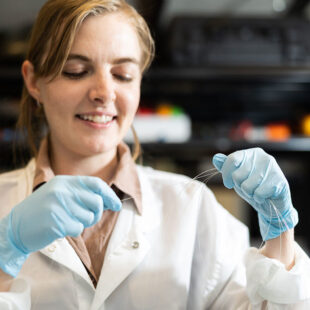K. Lisa Yang Brain-Body Center
Our Mission
The K. Lisa Yang Brain-Body Center creates novel tools to explore the multidirectional, multilevel interplay between the brain and other body organ systems with the goal of advancing therapies and predictive diagnostics to achieve healthy minds in healthy bodies.
Our Approach
The inextricable link between our brains and our bodies has been gaining increasing recognition among researchers and clinicians over recent years. Studies have shown that the brain-body pathway is multidirectional—meaning that our mental state can influence our physical health in many ways and vice versa. But exactly how they interact is less clear.
Philanthropist K. Lisa Yang, a former investment banker with a deep commitment to improving all aspects of human health, made a generous gift of $38 million to MIT to unlock this mystery. The K. Lisa Yang Brain-Body Center draws on MIT’s collaborative, interdisciplinary life sciences research and engineering community to focus on the complex conditions and diseases that result from brain-body interactions. The center’s researchers investigate the biological mechanisms underlying these interactions with the goal of unearthing knowledge that can lead to promising therapeutics to restore optimum function in both the nervous system and peripheral organ systems.
The K. Lisa Yang Brain-Body Center is directed by Polina Anikeeva, professor of materials science and engineering and brain and cognitive sciences at MIT, and an associate investigator at the McGovern Institute for Brain Research.
“A phrase I remember reading in secondary school has always stuck with me: mens sana in corpore sano—a healthy mind in a healthy body,” says Lisa Yang. “When we look at how stress, nutrition, pain, immunity, and other complex factors impact our health, we truly see how inextricably linked our brains and bodies are. I am eager to help MIT scientists and engineers decode these links and make real headway in creating therapeutic strategies that result in longer, healthier lives.”
Our Research
Initial projects at the center will focus on four major lines of research: the gut-brain connection, aging, brain–autonomic nervous system interactions, and acupuncture.
Frequent gastrointestinal problems are documented in individuals with autism spectrum disorders, Parkinson’s disease, depression, and anxiety. Our researchers are leading the way in developing and applying new technologies, including probes made of novel flexible fibers, to rigorously explore major neurobiological questions about gut-brain pathways. They are combining these innovations with sophisticated computational approaches to assess the mechanisms governing communication between the central nervous system and enteric (gut) nervous system. The aim is to pave the way for promising therapeutics to treat a host of brain and nervous system disorders.
Center researchers are pioneering molecular techniques to restore cellular homeostasis, that is, the equilibrium within cells affected by injury, degeneration, and other disease processes. Initially, they are identifying the changes in cells with altered homeostasis in three areas: liver damage, Huntington’s disease, and aging. At the genomic level, they are developing precision tools to edit the epigenome, which comprises chemical compounds that mark the genes in a cell in a way that tells them what to do and where and when to do it. The aim of this work is to erase accumulated “errors” of time, injury, or disease.
The two main branches of the autonomic nervous system—which regulates heart rate, blood pressure, respiration, body temperature, and other involuntary processes—are the sympathetic and the parasympathetic systems, which ramp up and slow down responses to stressors, respectively. Our scientists are designing new tools and imaging methods to study autonomic responses and sympathetic-parasympathetic system balance, including how pain influences these interactions and how autonomic responses in turn modulate pain perception, emotions, and other mental processes.
In collaboration with veterinarians in MIT’s Division of Comparative Medicine, center researchers are advancing techniques for documenting changes in brain and peripheral tissues induced by acupuncture. If successful, these techniques could lay the groundwork for a deeper understanding of the mechanisms of acupuncture, specifically how the treatment stimulates the nervous system and restores function.
The intestines are one of the most important and complex sources of this interoceptive input, but in the past, the information present in gut signals and their influence on brain activity has mainly been studied at the level of molecules and cells, rather than at an integrated level that spans organs and systems. Researchers will address higher-level aspects of interoception by applying a novel battery of imaging approaches to map neurochemical signaling dynamics in the gut, relating these dynamics to brain-wide activity, and probing pathways of information propagation from gut to brain using a variety of perturbations in rodents.

Our Researchers
Center researchers are taking a holistic approach bridging multiple fields of study to make revolutionary strides not only in our understanding of the links between the brain and the body’s peripheral organ systems, but also in how we approach human health overall.
